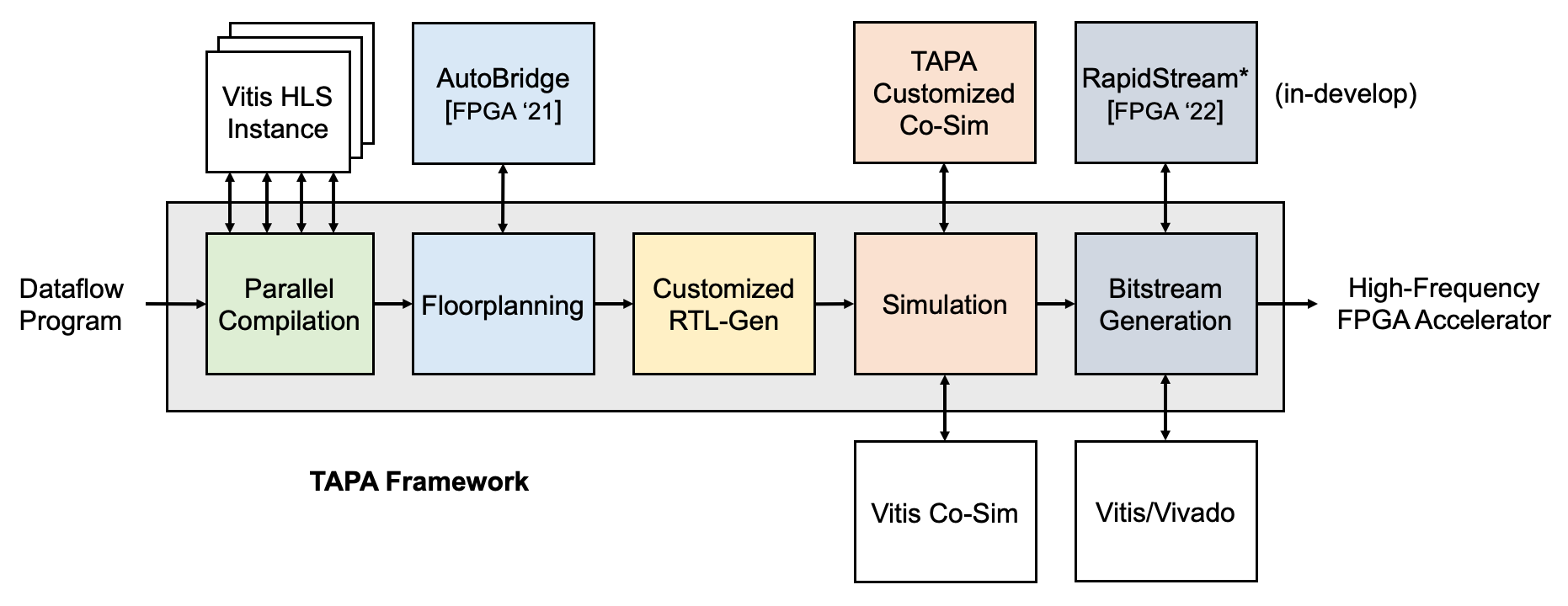Extending High-Level Synthesis for Task-Parallel Programs
Project description
TAPA
TAPA is a dataflow HLS framework that features fast compilation, expressive programming model and generates high-frequency FPGA accelerators.
High-Frequency
-
TAPA explicitly decouples communication and computation for better QoR.
-
TAPA integrates the AutoBridge floorplanner to optimize the RTL generation process.
-
TAPA achieves 2× higher the frequency on average compared to Vivado. 1
Speed
-
TAPA compiles 7× faster than Vitis HLS. 2
-
TAPA provides 3× faster software simulation than Vitis HLS.2
-
TAPA provides 8× faster RTL simulation than Vitis.
-
[in-progress] TAPA is integrating RapidStream that is up to 10× faster than Vivado.3
Expressiveness
-
TAPA extends the Vitis HLS syntax for richer expressiveness at the C++ level.
-
TAPA provides dedicated APIs for arbitrary external memory access patterns.
-
TAPA allows users to explicitly specify parallelism.
-
In addition to static burst analysis, TAPA supports runtime burst detectuion by transparently merging small memory transactions into large bursts.
HBM-Specific Optimizations
-
TAPA significantly reduce the area overhead of HBM interface IPs compared to Vitis HLS.
-
TAPA includes an automated design space exploration tool to balance the resource pressure and the wire pressure for HBM FPGAs.
-
TAPA automatically select the physical channel for each top-level argument of your accelerator.
Successful Cases
- Serpens, DAC'22, achieves 270 MHz on the Xilinx Alveo U280 HBM board when using 24 HBM channels. The Vitis HLS baseline failed in routing.
- Sextans, FPGA'22, achieves 260 MHz on the Xilinx Alveo U250 board when using 4 DDR channels. The Vivado baseline achieves only 189 MHz.
- SPLAG, FPGA'22, achieves up to a 4.9× speedup over state-of-the-art FPGA accelerators, up to a 2.6× speedup over 32-thread CPU running at 4.4 GHz, and up to a 0.9× speedup over an A100 GPU (that has 4.1× power budget and 3.4× HBM bandwidth).
- AutoSA Systolic-Array Compiler,
FPGA'21:
- KNN, FPT'20, achieves 252 MHz on the Xilinx Alveo U280 board. The Vivado baseline achieves only 165 MHz.
Getting Started
TAPA Publications
- Yuze Chi, Licheng Guo, Jason Lau, Young-kyu Choi, Jie Wang, Jason Cong. Extending High-Level Synthesis for Task-Parallel Programs. In FCCM, 2021. [PDF] [Code] [Slides] [Video]
- Licheng Guo, Yuze Chi, Jie Wang, Jason Lau, Weikang Qiao, Ecenur Ustun, Zhiru Zhang, Jason Cong. AutoBridge: Coupling Coarse-Grained Floorplanning and Pipelining for High-Frequency HLS Design on Multi-Die FPGAs. In FPGA, 2021. (Best Paper Award) [PDF] [Code] [Slides] [Video]
Project details
Release history Release notifications | RSS feed
Download files
Download the file for your platform. If you're not sure which to choose, learn more about installing packages.
Source Distribution
Built Distribution
Hashes for tapa-0.0.20240301.1-py3-none-any.whl
| Algorithm | Hash digest | |
|---|---|---|
| SHA256 | 5ba2281bd33bcb65ebcf81f8eb78858e097eea9fedae559ae812067d7bc47ffa |
|
| MD5 | 0ff0eb7fc33aaca80600df186f8f34bc |
|
| BLAKE2b-256 | 416e1b59d502987641e8ec99529e6234d507e648ccfd9d5033dca81043cadf89 |
















